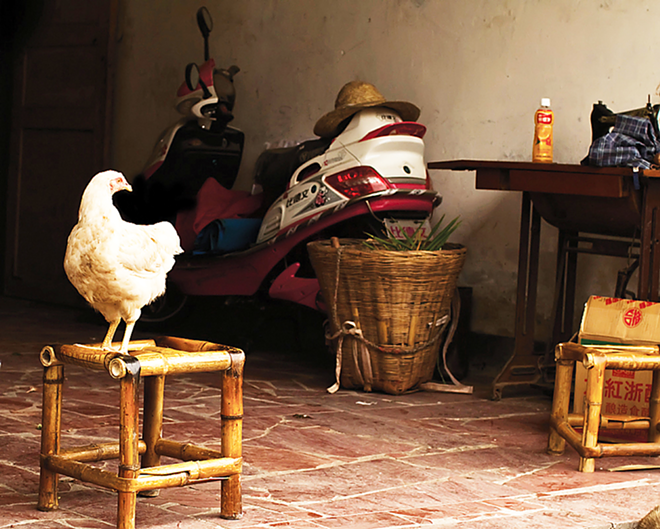
Since making her exit from corporate America three years ago, Sarasota-based photographer Aydelette Kelsey has been on a series of globetrotting adventures to China, Kenya, Cuba and other locales.
The peripatetic lifestyle comes naturally to Kelsey, who was born on a U.S. air base in the Philippines and lived up and down the East Coast and in St. Louis, where she picked up an MFA in creative writing at Washington University, before moving to Florida. Often organized around humanitarian causes — environmental research in Ecuador, medical aid to Cuba — the trips also provide Kelsey with opportunities to practice her art: photographing people and places.
Sixty-nine of her photographs are the focus of Others, Elsewhere, an exhibit at the Dunedin Fine Art Center, where Kelsey has taught classes in software for digital photo editing and graphic design. The images are straight travel photographs with no hidden conceptual agenda, though Kelsey puts some effort into avoiding the cliches of exoticism. (She also often gives her subjects prints of the photos and only sells prints, like those at DFAC, for nominal prices — so it would be hard to accuse her of exploiting anyone.) Last week, I toured the show with Kelsey, asking her to share some of the stories behind her images. She summed up her philosophy as a photographer by recalling a line from a poem by Jorge Luis Borges.
“When calamity strikes … we are rescued, we are saved, we are soothed by small acts of attention and memory,” Kelsey says. “I think that’s what photographs are — acts of attention and memory. And small. I think I’m not a great artist, I’m a small artist. I have to recognize that.”
Water for Bears, Baños, Ecuador, 2008. This photograph of a man lofting a bucket of water over his shoulder was the first to make Kelsey think: I’m a photographer now. Its setting is a small zoo owned by indigenous Ecuadorians, where spectacled bears, Andean foxes and capuchin monkeys (most of them once poached and unable to return to the wild) occupy modest cells made from earth. Kelsey’s task as an eco-tourist was to document the zoo in order to attract other eco-tourists. “When I went there, at first it was kind of a joke as a tourist attraction because it’s so humble. What it has become instead is a research place,” she explains. The man in the photo refills the bears’ water trough; his white T-shirt, ventilated where small holes have worn through, is impeccably clean.
Home, Jinzhu Zhuang Village, China, 2010. Kelsey’s photo frames a woman standing inside her wood-paneled home atop the largest expanse of rice terraces in China. The warmly-lit living space is organized around a cast iron stove, with a television tucked neatly underneath a nearby countertop. Another photograph in the exhibit provides a panoramic view of the 700-year-old terraces, which are carved into mountainsides.
Chicken, Motorbike, Sewing Machine, Ya’an City, China, 2010. Kelsey was walking by the open door of this urban home when her guide pointed out that the objects in the room recalled an antiquated Chinese adage that to be marriageable a young man needed a chicken, a mule and a tool of industry.
Floating Fish Seller, Lake Boringo, Kenya, 2011. A fisherman balances on a handmade bamboo canoe just big enough to hold his body while plying his trade. As tourists arrive at Lake Boringo, he lures eagles to the lake using small fish as bait; when the birds arrive to scoop up the fish, the tourists get their photo op. Kelsey says the man was surprised to be the subject of a photo for a change. “The reason I did it in black-and-white was that the lake looked so unnaturally colored,” she says. “It’s brown … full of sediment and tannin. The people who live on it are really proud of the color. They show you their teeth that are brown and say, this shows you that I’m from here. It’s a source of pride.”
Panta Rhei, Guanabacoa, Cuba, 2010. The title of the photograph means “everything flows” in ancient Greek. Kelsey used multiple exposures to capture 10 passers-by, including a gaggle of hip 20-somethings and a mid-century car, in front of a town hall building in eastern Havana. “In Cuba, you’re always so aware of time wrecking these buildings and not wrecking the people. It’s a strange mixture of modernity, joy, poverty and crumbling decay,” she says.
Masai with Baby, Masai Mara, Kenya, 2011. A young hunter poses with his daughter under a tree for this photo, while a little boy lingers in the background. Traveling through Kenya, Kelsey brought a battery-operated printer and shared prints with anyone who agreed to be photographed. In this particular village, her batteries ran out before any women could have a turn after the men. “This boy wanted to be in every picture,” Kelsey says. “He just stood in the background like a little ghost and unless someone chased him away he was in the picture.”
Change 1, 2 & 3, Huangshan City, China, 2010. Kelsey calls the woman who appears in this three-part portrait “the heart of the show.” In the first two photographs, she makes change for Kelsey, who has purchased a calligraphy brush from her; in the third, she smiles and waits to be photographed one more time. “I love that moment when people feel attended to,” Kelsey says.

